A carbon star is typically an asymptotic giant branch star, a luminous red giant, whose atmosphere contains more carbon than oxygen. The two elements combine in the upper layers of the star, forming carbon monoxide, which consumes most of the oxygen in the atmosphere, leaving carbon atoms free to form other carbon compounds, giving the star a "sooty" atmosphere and a strikingly ruby red appearance. There are also some dwarf and supergiant carbon stars, with the more common giant stars sometimes being called classical carbon stars to distinguish them.

R Coronae Borealis is a low-mass yellow supergiant star in the constellation of Corona Borealis. It is the prototype of the R Cor Bor class of variable stars, which fade by several magnitudes at irregular intervals. R Coronae Borealis itself normally shines at approximately magnitude 6, just about visible to the naked eye, but at intervals of several months to many years fades to as faint as 15th magnitude. Over successive months it then gradually returns to its normal brightness, giving it the nickname "reverse nova", after the more common type of star which rapidly increases in brightness before fading.

W Mensae is an unusual yellow supergiant star in the Large Magellanic Cloud in the southern constellation Mensa. It is an R Coronae Borealis variable and periodically decreases in brightness by several magnitudes.
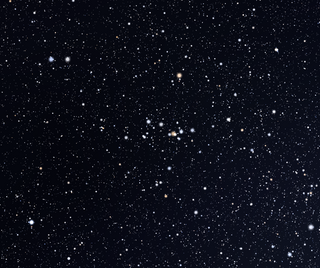
DY Persei is a variable star and carbon star in the Perseus constellation. At maximum it is 11th magnitude and at its faintest it drops to 16th magnitude. DY Persei is the prototype of the very rare DY Persei class of variables that pulsate like red variables but also fade from sight like R Coronae Borealis variables.

A yellow supergiant (YSG) is a star, generally of spectral type F or G, having a supergiant luminosity class. They are stars that have evolved away from the main sequence, expanding and becoming more luminous.

UX Antliae is a post-AGB and R Coronae Borealis variable star that has a base apparent magnitude of around 11.85, with irregular dimmings down to below magnitude 18.0.
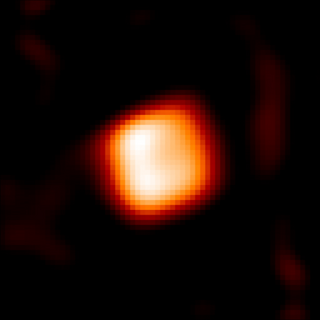
RW Cephei is a K-type hypergiant and a semirregular variable star in the constellation Cepheus, at the edge of the Sharpless 132 H II region and close to the small open cluster Berkeley 94. It is among the largest stars known with a radius of almost 1,000 times that of the Sun (R☉), nearly as large as the orbit of Jupiter.
FG Sagittae is a supergiant star in the constellation Sagitta at a distance of 4000 light-years. When first noted in 1943, it was identified to be a variable star, and it was found to be a hot, blue star of stellar spectral type B in 1955. Since then it has expanded and cooled, becoming a yellow G-type star by 1991, and then further cooling to become an orange K-type star. It started to pulsate when becoming an A-type star with a period of 15 days. This period later increased to over 100 days.
An extreme helium star is a low-mass supergiant that is almost devoid of hydrogen, the most common chemical element of the Universe. Since there are no known conditions where stars devoid of hydrogen can be formed from molecular clouds, it is theorized that they are the product of the mergers of helium-core and carbon-oxygen core white dwarfs.
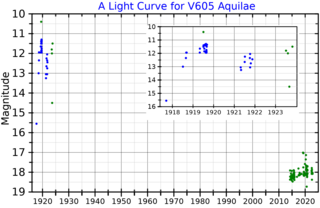
V605 Aquilae, in the constellation Aquila, is the variable central star of the planetary nebula Abell 58. It is a highly unusual hydrogen-deficient carbon-rich star.
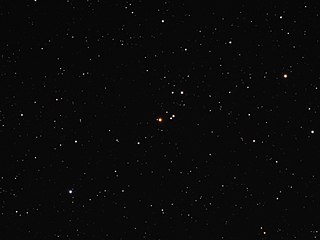
SU Andromedae is a carbon star in the constellation of Andromeda. It is a variable star classified as a slow irregular pulsating supergiant, and varies from an apparent visual magnitude of 8.5 at minimum brightness to a magnitude of 8.0 at maximum brightness with no clear period.

RY Sagittarii is a yellow supergiant and an R Coronae Borealis type variable star in the constellation Sagittarius. Although it ostensibly has the spectrum of a G-type star, it differs markedly from most in that it has almost no hydrogen and much carbon.

Z Ursae Minoris is a carbon star and R Coronae Borealis variable in the constellation Ursa Minor.
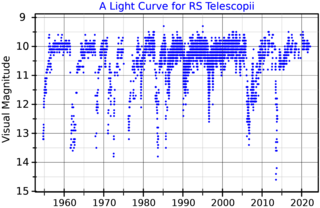
RS Telescopii, abbreviated RS Tel, is a variable star in the southern constellation of Telescopium. It is a dim star with an apparent visual magnitude of 10.67, which is much too faint to be visible without a telescope. The variability of this star was discovered by Evelyn F. Leland and announced by Edward C. Pickering in 1910. It was first studied by Cecilia H. Payne in 1928 at the Harvard College Observatory.

V Coronae Australis is a R Coronae Borealis variable (RCB) star in the constellation Corona Australis. These are extremely hydrogen-deficient supergiants thought to have arisen as the result of the merger of two white dwarfs; fewer than 100 have been discovered as of 2012. V Coronae Australis dimmed in brightness from 1994 to 1998.
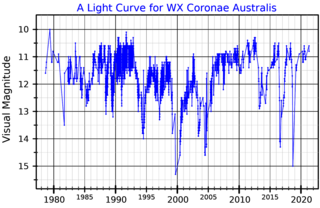
WX Coronae Australis is an R Coronae Borealis star in the constellation Corona Australis, one of the brightest examples of this extremely rare class of variable star. Despite the rarity, Corona Australis hosts another R CrB star, V Coronae Australis.

S Apodis, also known as HD 133444 is a variable star located in the southern circumpolar constellation Apus. It has an apparent magnitude ranging from 9.6 to 17, which is below the limit for naked eye visibility. The object is located relatively far at a distance of approximately 15,000 light years based on Gaia DR3 parallax measurements, but it is drifting closer with a heliocentric radial velocity of −75 km/s.

A hydrogen-deficient star is a type of star that has little or no hydrogen in its atmosphere. Hydrogen deficiency is unusual in a star, as hydrogen is typically the most common element in a stellar atmosphere. Despite being rare, there are a variety of star types that display a hydrogen deficiency.

DY Centauri is a variable star in the constellation Centaurus. From its brightness, it is estimated to be 7000 parsecs (23000 light-years) away from Earth.
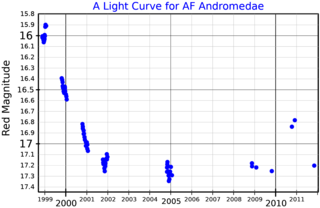
AF Andromedae is a luminous blue variable (LBV), a type of variable star. The star is one of the most luminous variables in M31, the Andromeda Galaxy.


















